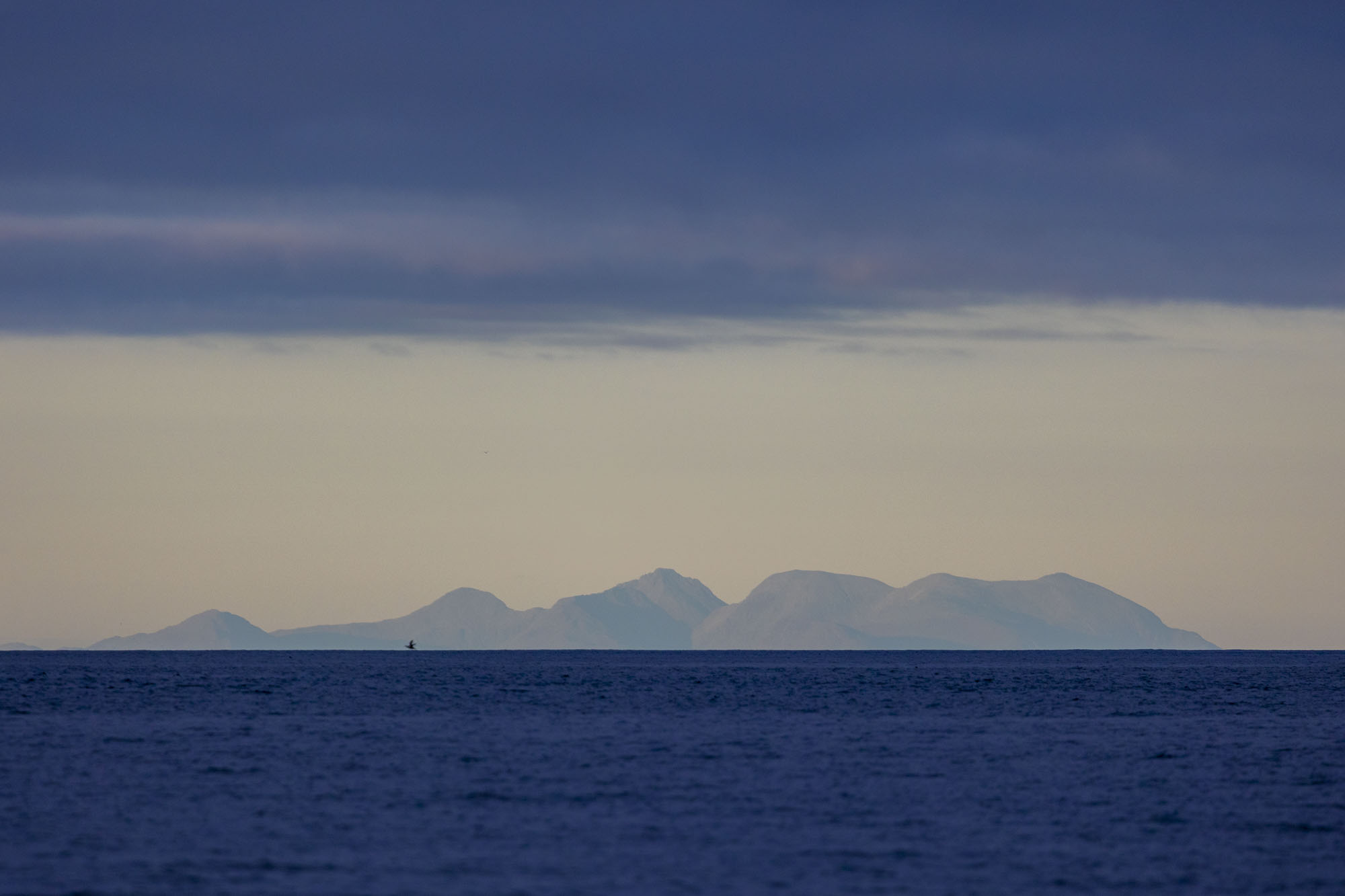With the happy news that my burn was fit to sail on, Trilleen positioned back south from Castlebay towards Barra Head, enjoying a brief but satisfying light wind sail out of the harbour limits before the wind fell further away. The forecast was for the wind to fall lighter and lighter from the north before a possible brief southerly filled in on Monday. Light wind sailing isn’t really Trilleen’s thing, although she would be much improved by a light 150% Genoa or Code Zero type sail on a top down furler. That will of course mean a bowsprit and more work to the boat. Sigh.

As I came into the lee of Mingulay, scant miles north from the tip of Barra Head the Atlantic swell was suppressed well enough that I was able to anchor on east side of the island in a steeply shelving sandy bay fringed by tortured rocks. The sand was wholly occupied by a seal colony of hundreds, whose perpetual sighing singing was the soundtrack for my night. Massed choirs of selkies have an uncanny give an uncanny modulated keening sound which mixed with the broadband roar of remaining swells breaking onto the beach is an uncanny mix.

I anchored slightly further out than I might have, and was pleased the seals payed me no heed. This is their home, and they still had pups, big pups, but pups nonetheless ashore in their downy brown fur.

In the evening light the mountains of Rum and Skye reared up from the horizon 40 miles away across the Minch, a reminder of the great bulk of the inner Hebrides lying the other side of the often violently disturbed Minches – which this night were calm and quiet.

The next morning was frighteningly calm, a warning that the conditions in the Atlantic were about to change, the swell oily smooth, and the cloud base hanging low over at perhaps 500ft obscuring the top of Barra head and the lantern of the major light there, as Trilleen and I hooked a U Turn round the south end of the Outer Hebrides. The commonness of cloud here means the pilot guide warns that it is possible to come within 1/4 of nautical mile of the head before the loom of the lantern becomes visible in the cloud. That, for a major headland is a big problem. Fortunately the Northern Lighthouse Board have fitted the light with an AIS beacon which screams the presence of the headline into any vessel with a receiver.

The calm sea made for an easy, and short trip up the western fringe of Barra, close enough in to admire the shining dunes, calm today, but where almost all year round the whole terrifying might of the Atlantic discharges the energy built mile by mile across the vastness of its passage from Canada. The south wind – forecast to fill from further out, touched Trilleen and I had several delightful sailing hours, drifting along at 3kt under full sail, before it died again.

Turning east to pass through Barra Sound, one of the many fine pilotage passages of the Western Isles between the Atlantic and the Minch, threading between rocks and breakers, to be greeted by a pod of dolphins busy hunting in the strongly tidal waters of the sound’s interior before breaking back out into the Minch to the east of the islands,
Barely clear of the Sound of Barra I turned Trilleen north close under the coast bound for Arcairseid Mhor on Eriskay. Over my stern two much larger yachts approached, and I hoped they were not heading to Eriskay where the anchorage is tight for more than a few boats. It turns out they were not, no doubt heading north to the joy absent comfort of a marina in Loch Boisdale or Stornoway. Arcairseid Mhor like most good anchorages here is hidden in a fold in the rocks a bay behind a dog leg channel

The shallows negotiated the bay opened up to a pool 8m deep, occupied by a yacht whose crew – with more faith in their anchor than I ever have – were firmly vanished ashore where they remained until the next day. As I set the anchor and enjoyed a quiet cup of tea, Eriskay ponies – the specialist horses bred for the crofters as ‘tractors’ in the pre-mechanisation age were grazing on the hills. Each is owned by a crofter, but to save on fodder, in the summer months they graze in herds loose in the islands common grazing.

The advertised visitors buoys were not present, but I had had the anchor ready so it was an easy matter to pick a spot and drop the hook before settling back midway between the fishing pontoon and anchored yacht. It was perhaps good thing I had economised on mooring space because a few hours later another small yacht, Cat Balou (of which there are many), anchored the other side.
I moved the next morning to the centre of the anchorage. The seabed here is black mud and shell, the sort of boat filthy making bottom which reminds me of the east coast, and also reminds me that fitting a deck washdown pump should be a priority. After seeking counsel from the local fishing fleet who have a small council run pontoon in the corner of the bay about obtaining diesel and water, the later no problem, the former impossible for the present because of rebuilding works at the pier, I was invited to come alongside the inside of their pontoon to weather the coming front. That meant I could easily take the wheelchair over the spine of the island, visit the Eriskay Store, and have a very acceptable lunch at Am Politician, the pub named in favour of the SS Politician whose lost cargo of whisky is the inspiration for the book and film, Whisky Galore.